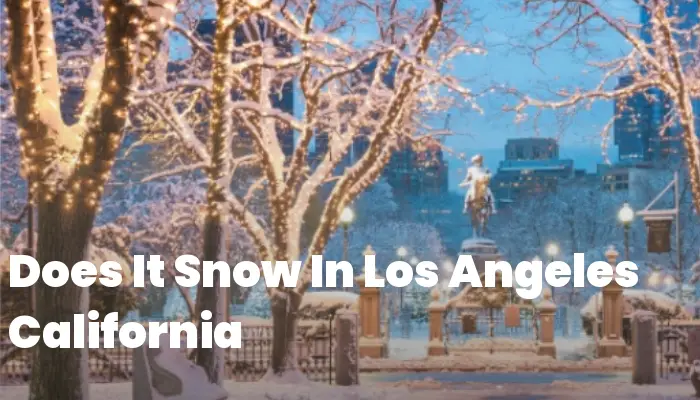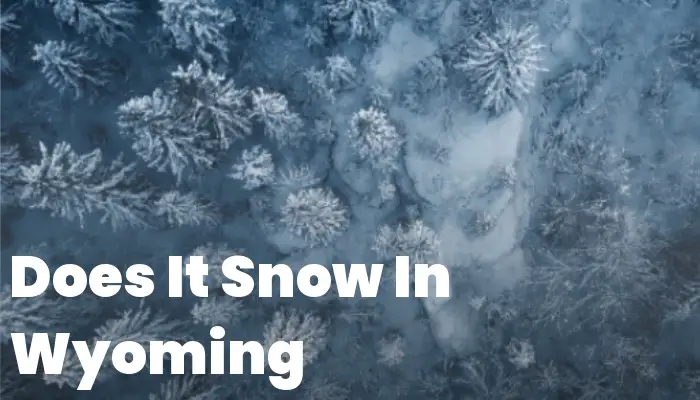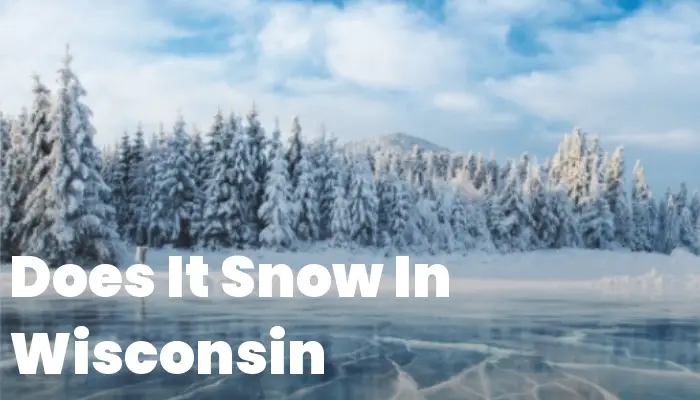Does it snow in Los Angeles, California? This might seem like an improbable question, but in fact, it’s one that many people often ask. Los Angeles, widely known for its warm climate and sun-soaked beaches, isn’t typically associated with snowfall. But does that mean it never experiences the fluffy white stuff? Join us as we dig into the meteorological records and uncover the surprising truths about snow in Los Angeles.
From historical snow events to modern day climate data, we’re going to examine if LA ever swaps its palm trees for a winter wonderland.
Does It Snow In Los Angeles, California?
The idea that Los Angeles, the city of angels and endless summer, might experience snow seems like a contradiction. Yet, history tells us that it is not impossible. While it’s certainly not common, there have been rare occasions when snowflakes have made an appearance in this Southern California metropolis.
The last significant snowfall in downtown Los Angeles occurred on January 22, 1962. Residents woke to a light dusting of snow across the cityscape—a sight so rare that it became a memorable event for those who experienced it. Occasionally, some of the surrounding mountains and foothills receive a light dusting during colder winters.
However, true accumulations within the main urban areas are incredibly uncommon due to LA’s subtropical Mediterranean climate. Mostly, the city enjoys mild winters with temperatures rarely dipping below 45 degrees Fahrenheit (7 degrees Celsius). So while snow isn’t entirely out of the question in Los Angeles proper, don’t expect to build many snowmen if you’re visiting between November and February.
How Much Does It Snow In Los Angeles, California?
When exploring how much it might snow in Los Angeles, we rely on meteorological records that point to infrequency and minimal accumulation. Looking back at historical weather data reveals that significant measurable snowfall within the city is extremely rare.
Most of the time, if cold enough conditions do occur during winter storms passing through Southern California, only trace amounts of snow are recorded—if any at all. These transient occurrences are more likely to be found on high ground away from coastal influence—namely regions like the San Gabriel Mountains or other nearby ranges where elevation plays a key role in temperature drops.
In fact, mountain communities such as Big Bear Lake or Mount Baldy regularly see winter snow due to their altitudes exceeding 6,000 feet (1,828 meters). But for most parts of LA County itself? It’s more accurate to say that ‘snow’ largely remains an abstract concept rather than a seasonal reality for residents.
The Rarity of Snowfall Within The City Limits
For those dreaming of snowy streets around iconic landmarks such as Griffith Observatory or Santa Monica Pier—it remains just that: a dream. The proximity to sea level and Pacific Ocean currents help keep things too warm throughout winter months for regular snow events.
Are There Ice Storms In Los Angeles California?
To address another weather phenomenon—ice storms—one must first understand what they entail: events characterized by freezing rain producing ice accumulations that can cause severe damage and hazardous conditions.
In this regard, Los Angeles is once again mostly spared from such extreme weather behavior due largely to its moderate climate patterns. An ‘ice storm’, per se—involving significant layers of ice coating surfaces—is virtually unheard-of here.
That’s not to say LA doesn’t witness its share of cold fronts or chilly rains; however these episodes lack both intensity and frigidity necessary for an ice storm scenario found in colder climates elsewhere in North America.
No Ice Storms But Occasional Frost Advisories
Frost advisories may occasionally go into effect during particularly cool nights mainly across interior valleys where temperatures drop closer towards freezing—but even then such occurrences lead mostly just towards morning frost rather than an outright ice storm event typical those seen elsewhere.In conclusion: yes—it can technically snow but its occurrence is exceptionally unusual within broad limits while genuine ice storms remain essentially non-existent based upon local meteorological patterns.This concludes our exploration into whether there lies possibility encountering snowy icy landscapes amid bustle sunshine prominent City Angels.If considering move visit question should hardly factor decision-making given clear-skied history we’ve detailed above!
Los Angeles, California, is known for its mild Mediterranean climate, which typically doesn’t lend itself to snowy winters. According to the article “Does It Snow In California,” while snow is a rare spectacle in the city, it is not entirely impossible. On occasion, the surrounding mountains of Los Angeles receive a dusting of snow, offering a picturesque backdrop to residents. However, snowfall within city limits happens only under specific and infrequent conditions. For those curious about experiencing snow in California, they are more likely to find it in higher elevations or the northern parts of the state rather than in Los Angeles itself.
Where Does It Snow In Los Angeles, California?
Snow in the greater Los Angeles area is a spectacle mostly confined to higher elevations and the occasional freak weather event. When searching for snowfall within LA County, one must turn their gaze toward the hilly terrains and mountain passes.
The most notable locations for snow within driving distance of downtown Los Angeles involve a trip into the San Gabriel Mountains or further afield to the San Bernardino Mountains. Areas such as Mount Wilson, which stands over 5,700 feet (1,737 meters) above sea level, and resort towns like Wrightwood, Lake Arrowhead, and Big Bear Lake provide winter sports enthusiasts with their snow fix.
Despite these snowy escapes being part of Los Angeles County or adjacent areas, they are not reflective of what one would experience in the urban heart of LA. These high-altitude sites are geographical anomalies that receive regular snowfall during winter months—offering skiing, snowboarding, and other wintertime activities just a stone’s throw from palm-lined streets that typically bask in much warmer weather.
Closeness to Winter Recreation Areas
For residents craving snowy landscapes without having to deal with them daily during winter, Los Angeles’ proximity to these winter recreation areas is an added benefit. You could feasibly surf in the morning and hit the slopes by afternoon—a testament to Southern California’s diverse microclimates.
Los Angeles California Roads and Winter Weather Conditions
Even though it doesn’t often snow within urban Los Angeles, winter weather conditions can still affect road safety. Primarily, this concern arises during periods of heavy rainfall when roads become slick and prone to flooding. The city’s infrastructure can be challenged by storms given that LA is accustomed to arid or mild conditions most of the year.
However, for those commuting from or traveling to regions where it does snow such as through the Grapevine on Interstate 5, winter road conditions can become hazardous quickly due to elevation gain leading into Tejon Pass—and chains may be required during heavy snow events.
City officials generally do an excellent job at keeping major highways clear of significant hazards, but drivers should always remain cautious during wetter months—whether they face rain-soaked highways or potentially icy mountain passes.The local Department of Transportation issues timely alerts regarding road closures or advisory notices for those venturing into areas where weather might impact travel.
Safety Tips for Driving During Winter Weather Events In LA
When navigating potential wintry roads within or around Los Angeles:
- Maintain your vehicle well; ensure tires have good tread;
- Avoid sudden starts and stops;
- Increase following distance;
- Pack emergency supplies—including chains—if heading into snowy terrain.
This proactive approach towards unpredictable winter conditions ensures both safety and peace-of-mind while traversing various parts Southern California’s vast network routes.
How Cold Does It Get In ,California?
While notorious heatwaves make headlines during summer months usually remain fairly comfortable come wintertime—especially comparison cities experiencing traditional freezing temperatures associated deeper seasonal shifts.
Average lows December through February hover between mid 40s (around Celsius). However overnight dips 30s (single digits Celsius) aren few far between particularly inland valley areas away moderating coastal influences ocean currents.
The Coldest Months And Microclimates
January February considered coldest months entire region not only sees shortest days least amount sunlight but also experiences occasionally powerful Pacific storms can dramatically decrease mercury albeit temporarily.
Moreover unique microclimates present throughout county mean actual experienced temperature vary quite bit depending geographic location—for instance higher altitudes more susceptible frosting some lower-lying districts may only feel slight chill air.
While many may wonder, Does It Snow In Los Angeles California, it’s interesting to compare the weather patterns of other cities within the same state.
For comparison, let’s take a look at Fresno, another city in California. Snowfall is even more rare here than in Los Angeles.
Similarly, snow is also quite uncommon in San Diego. While it doesn’t snow frequently, there have been instances where San Diego has seen flurries.
Traveling North to San Francisco, snowfall remains a rare occurrence. The question, “Does It Snow In San Francisco California?” would often be answered with a no due to its coastal climate.
Lastly in comparison, the city of San Jose sees very little snowfall as well. Its Mediterranean climate brings mild winters without much snow. Despite being within the same state of California, these cities all see varying degrees of wintry weather.
Winter Activities In Los Angeles California
When the temperature dips and the distant mountains dust with snow, Los Angeles reveals a surprising array of winter activities to enjoy. While the heart of the city may not see much of the white stuff, Angelenos love taking advantage of their unique geography.
Visiting nearby winter resorts like Big Bear and Mountain High becomes a favorite pastime for those seeking skiing or snowboarding adventures. These areas offer not only snow sports but also charming village atmospheres perfect for family getaways or romantic retreats.
Ice skating is another popular activity, with several seasonal rinks popping up throughout the city, including picturesque locations like Pershing Square in Downtown LA or by the beach in Santa Monica. It’s an enchanting contrast to skate on ice while surrounded by palm trees under sunny skies.
In addition to these more traditional winter pursuits, there are numerous holiday events that captivate locals and tourists alike. From Downtown’s holiday markets to Christmas light boat parades in various coastal communities, there’s no shortage of festive spirit even without typical snowy scenes.
Exploring Los Angeles’ Winter Wonderland
For those willing to venture into nature, hiking trails in places like Griffith Park can offer breathtaking views of snow-capped peaks after a fresh storm – ensuring even hikers get a taste of winter without enduring harsh conditions.
Winter Traveling In Los Angeles California
Winter traveling in Los Angeles may not involve navigating through blizzards or shoveling out your car but it does come with its own set of considerations.
Rainy season preparations are essential as this is when LA receives most of its precipitation. Torrential downpours can lead to slick roads and occasional mudslides especially along canyon routes such as those found in Malibu or along Pacific Coast Highway.
Furthermore traffic congestion typically worsens during wet weather requiring travelers to allocate extra time for commutes and be vigilant about road conditions. Even though snow isn’t a factor within the city proper unexpected weather changes at higher elevations can catch drivers off guard leading them into potentially snowy situations if traveling towards mountainous areas.
Local authorities provide resources like traffic apps and websites that issue real-time updates on road conditions which are invaluable during times when sudden storms hit. The key is being aware staying informed so that any journey whether short distance within county limits longer haul trips outside Los Angeles Basin remains safe viable option throughout cooler months.
- Check weather reports before setting out;
- Familiarize yourself with your route including alternate options;
- Carry emergency kits stocked essentials such blankets food water flashlights.
This forward thinking helps mitigate many perils associated wintertime travels across diverse terrains climates found Southern California.
Tips for Navigating LAX During Winter Holidays
Traveling through Los Angeles International Airport (LAX) can be particularly daunting during holiday periods when passenger volume spikes dramatically. To ensure smoother transitions:
- Aim arrive airport well ahead scheduled flight times due extra security lines boarding processes;
- If possible opt services like TSA PreCheck Global Entry streamline passage checkpoints;
- Pack patience remember everyone else trying make their way too!
…
.
.
.
.


